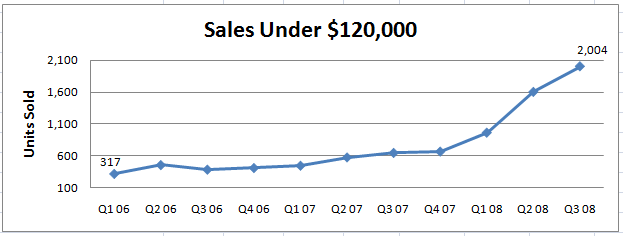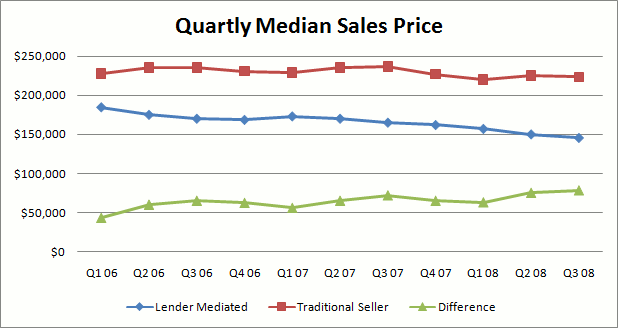In mid-October, MAAR released their Q3 foreclosure and short sale report, which I co-authored with the talented Jeff Allen. Business has been brisk for me so I haven’t had a lot of time to sit down and provide my thoughts on the data as I have in previous quarters (1) (2) so my apologies for the delay.
The most important features of this report in my opinion are the ability to understand the impact of lender mediated sales in our market and to spot trends in both where this market has been and where it is going. Q3 data shows the same trends as before… mainly that the share of our current housing market that is a foreclosure or a short sale continues to increase.
Median Sales Price
Median Sales Price is a huge part of the story. While Traditional Sellers have seen their sales prices fall, their sales price is down only 4.6% from 2 years ago, while Lender Mediated Sellers have seen their prices decline 9.1%. This means the disparity between the average Lender Mediated home vs. Traditional Seller home has grown from $65,000 in Q3 2006 to $76,000 in Q3 2008.
The Resurgence of Homes Under $120,000
In 2006 we had a total of 1567 in the 13 county metro area that sold at or below $120,000. This year, we’ve had 2004 homes under $120,000 sell in just the 3rd quarter, July 1 – September 30, 2008. The chart below shows the phenomenal resurgence in homes priced at the lowest end of our market. This poses two issues: first, there’s been a huge resetting of home affordability at the low end of the market… I know many agents in my office who did their first sub-$100,000 sale in many years this year and I’d say in about 3/4ths of the sales it was a 1st time buyer purchasing the home. The second issue is a question of condition. While this huge surge in sales under $120,000 suggests great inroads to affordability, it is often coming in part due to the substantial decline in the homes’ condition. The last time we saw 2,000+ sales under $120,000 in the 3rd Quarter was in 2000!

The Decline of the Traditional Seller
While Traditional Sellers have seen their median sales prices fall in the last two years, the slip has been fairly small in comparison to the sales price gains seen up to 2006. What we have seen though is a 40% decrease in the number of homes listed and sales closed by Traditional Sellers in the last 2 years. This is likely from many factors but I believe that much of that decrease is because sellers owe more than their house is worth today and they either do not have the cash to pay the difference or they don’t want: “to have to pay for the priviledge of selling their house.”
In today’s market, here’s an approximate amount a seller needs in cash/equity to move from a house valued at $200,000 to one valued at $300,000:
- $13,000 – $15,000 – sales commision and closing costs on current home
- $5,000 – $7,000 – closing costs/prepaids on new home (could be rolled into loan by having seller of new home pay closing costs)
- $10,500 – $15,000 – 3.5% – 5% down payment for new home
Therefore it is likely to cost a minimum of $23,500 in cash/equity t o move, which is 11.75% of the value of the $200,000 house owned by the person in this example. Though the housing downturn today makes it an excellent time to make a “move up” purchase since price declines on the sell side can be made up on the buy side, unless a prospective move-up buyer has the cash required, they cannot take advantage of this market. Though asking a homeowner to have a little more than 10% equity in a house to plunk down a new one isn’t an unreasonable request, for many years sellers put down 0% and spent their down payments on anything/everything else so this comes as a 1-2 punch to our market today. Really the cash requirements of today are just the same requirements of a decade ago. While the equity impact on sellers’ ability to become move-up buyers affects sales, I believe there’s a larger reason for today’s lower sales:
One-Sided Transactions Lead to Far Fewer Sales
If we look back at the housing market for most of the last 50+ years, we find that most transactions had a Traditional Seller who would sell their home to a buyer. That seller would then go on to purchase another home from the next seller. That seller would then go on to purchase another home, etc. With a Lender Mediated Seller, either the seller is a bank who is never a buyer, or it is a seller in financial hardship who very rarely has the financial or credit wherewithal to purchase another home. If you take a guess that 50% of sellers historically went on to purchase another home after selling theirs, then the 4,110 Lender Mediated sales in Q3 2008 would have produced an additional 2,055 sales. In from Q3 2006 our sales are down 1,531 units, so an argument could be made that our sales would have met or beat 2006 sales if it were not for the current influx of lender mediated inventory. This example is very simplistic and doesn’t factor in myriad variables to our market, but you get the idea of the impact that lender mediated sales have on our market.
Are we Approaching a Fundamental Value in Lender Mediated Sales?
This year has seen the resurgence of the multiple offer. I can’t remember hearing about multiple offers in such great quantity since 2004 or 2005. Nearly all these multiple offer situations that I have seen or heard about have been on lender-involved listings. While I’ve seen many overpriced houses languish on the market for months, when the seller prices it right from the get-go, buyers seem to come out of the woodwork. In most of these situations the house ends up selling at or above asking price… sounds awefully familiar to stories from a few years ago, doesn’t it? From what I’ve learned, it looks like the typical lender-mediated house (in particular foreclosures) are selling for 60% – 70% of the property’s previous sales price. This is a number that’s low enough to account for issues with condition and disclosure and still motivate buyers to make an offer. Can prices fall further from this point? You bet. The difference is that there seems to be strong support at that level, as evidenced by the multiple buyers that come forward with offers at that price point.
Where do we go from here?
2008 is likely to end with nearly 1 in every 2 sales in the 4th quarter being a foreclosure or short sale. 2009 will likely start off where 2008 ended, but mid-2009′s activity is going to largely depend on the decisions of Washington and of the big mortgage lenders throughout the country. If lenders become more willing to renegotiate loan terms and/or the economy turns back around, the housing market may finally stabilize. If those hopes do not come to fruition, 2009 will likely end up looking a lot like 2008 in terms of sales volume and likely see sales prices fall another 2%-5% from this year’s numbers.






[...] Updated Report: Foreclosures & Short Sales in Twin Cities [...]